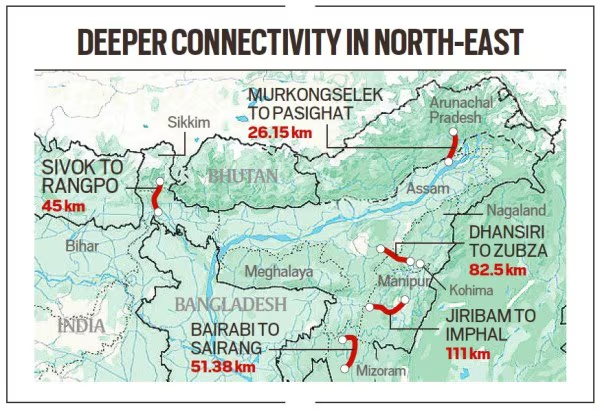
Aizawl Becomes Fourth N-E Capital with Rail Link: Trial Run Successful
Introduction: Why is this in News?
In a significant development toward improving connectivity in the North-Eastern region of India, Aizawl, the capital of Mizoram, has become the fourth North-Eastern capital to be linked with the national railway network. This connection was made through the Bairabi–Sairang railway line, and the trial run has been successfully completed. The final safety check is scheduled for this week, and the line is expected to be inaugurated after June 17, 2025.
This development is historically important for infrastructural development, regional integration, and economic upliftment of the North-East and is relevant for CLAT Current Affairs 2026 and UPSC GS Paper 2 and 3 under governance, infrastructure, and regional development.
Key Highlights and Point-wise Summary
- Aizawl Connected to Indian Railways
- Aizawl has become the fourth capital in North-East India to be connected by rail.
- The connection has been made through the Bairabi–Sairang line, a 51.38 km stretch.
- Trial Run Success
- The railway trial run was successfully conducted, marking a key milestone.
- A final safety inspection will take place this week, post which the line will be officially inaugurated after June 17.
- Significance of Bairabi–Sairang Railway Line
- Bairabi is located in the Kolasib district, close to the Assam border.
- Sairang, a satellite town of Aizawl (20 km away), is the current endpoint of this railway line.
- The project improves last-mile connectivity to the state capital.
- Fourth NE Capital on Railway Map
- Prior to Aizawl, only three N-E state capitals had rail connectivity:
- Guwahati (Assam)
- Itanagar (Arunachal Pradesh via Naharlagun)
- Agartala (Tripura)
- Now, Aizawl joins this group as the fourth capital with a functioning railway link.
- Prior to Aizawl, only three N-E state capitals had rail connectivity:
- Strategic Map of Northeast Railway Projects (as per Indian Express visual)
- Ongoing or completed rail projects in the region:
- Murkongselek to Pasighat: 26.15 km (Arunachal Pradesh)
- Sivok to Rangpo: 45 km (Sikkim)
- Dhansiri to Zubza: 82.5 km (Nagaland)
- Jiribam to Imphal: 111 km (Manipur)
- Bairabi to Sairang: 51.38 km (Mizoram)
- Ongoing or completed rail projects in the region:
- Importance for Regional Development
- Boosts economic growth, tourism, and employment in the North-East.
- Enhances logistics and supply chains, especially for defense and essential services.
- Promotes integration of remote regions with the rest of India.
- Government’s Commitment to NE Connectivity
- The project is part of the Act East Policy and the PM Gati Shakti National Master Plan.
- Railway projects in NE are often delayed due to challenging terrain, funding, and land acquisition issues.
- Despite this, the Indian Railways is pushing to connect all NE state capitals by 2030.
Explanations of Peculiar Terms (CLAT-friendly Notes)
- Satellite Town:
- A smaller urban area that is located near a larger city and supports its population or activities. Sairang is a satellite town of Aizawl.
- Trial Run:
- A non-commercial test operation of a new railway line or service to ensure its safety and functionality.
- Bairabi:
- A small town near the Mizoram-Assam border that acts as the railhead (starting point) of the Bairabi–Sairang rail line.
- Railhead:
- The farthest point to which a railway line extends. It often serves as a logistical hub.
- Act East Policy:
- India’s strategic initiative to promote economic and strategic relations with the extended neighbourhood in the Asia-Pacific region.
- PM Gati Shakti Plan:
- A holistic infrastructure development initiative to ensure multimodal connectivity across the country.
Broader Context for CLAT 2026 Aspirants
Relevance to Indian Polity and Governance:
- The Indian Constitution promotes equitable regional development under the Directive Principles of State Policy.
- Railway is a subject under the Union List (Entry 22), meaning only Parliament can legislate on it.
- Infrastructure expansion in North-East showcases cooperative federalism and inclusive governance.
Relevance to Indian Economy:
- The rail connection is expected to reduce transportation costs, improve market accessibility, and strengthen supply chains.
- Key for logistics-driven economic corridors, especially in the North-East Industrial Corridor.
Relevance to International Relations:
- North-East is a strategic region sharing borders with Bangladesh, China, Bhutan, and Myanmar.
- Improved railway links can support India’s Look East/Act East Policy and boost cross-border trade.
Timeline of Bairabi–Sairang Railway Project (Important for Mains/Essay)
Year | Milestone |
2015 | Foundation laid for the Bairabi–Sairang project |
2019 | Major construction activities began |
2022 | Tunnel boring and bridge construction achieved 70% |
2024 | Line nearing completion, final tracks laid |
2025 | Trial run successful; inauguration planned post-June |
Challenges Faced in Execution
- Difficult terrain with high gradients and unstable hills.
- Over 80% of the project comprises tunnels and bridges.
- Heavy monsoon delays and landslides affect construction schedules.
- Environmental clearance and displacement of local tribal communities needed to be handled sensitively.
Why This Is Important for CLAT and Other Law Exams
- Legal Framework:
- Railway land acquisition governed by Right to Fair Compensation and Transparency in Land Acquisition Act, 2013.
- Environmental clearances governed under Environment (Protection) Act, 1986 and Forest Rights Act, 2006.
- Constitutional Implications:
- Reflects Article 21 (Right to life and personal liberty) in terms of infrastructure access.
- Article 38 emphasizes minimizing inequalities in income and status across regions.
- Case Laws and Precedents:
- Legal disputes often arise in large infrastructure projects due to environmental violations, tribal land rights, and compensation issues.
Future Prospects
- Enhanced economic growth in Mizoram through tourism, agro-business, and handicrafts.
- Better disaster response mechanisms with improved evacuation capabilities.
- Boost to defense logistics, given the proximity to international borders.
- Potential for regional express freight corridors in the future.
Conclusion
The successful trial run of the Bairabi–Sairang railway line, connecting Aizawl to the national railway network, is a landmark moment for North-East India. It not only enhances regional integration but also furthers the goals of equitable development and national security. For aspirants of CLAT 2026, this development is crucial from the perspective of legal, constitutional, environmental, and economic awareness. Infrastructure developments like these provide excellent case studies in essays, GK sections, and interviews.




